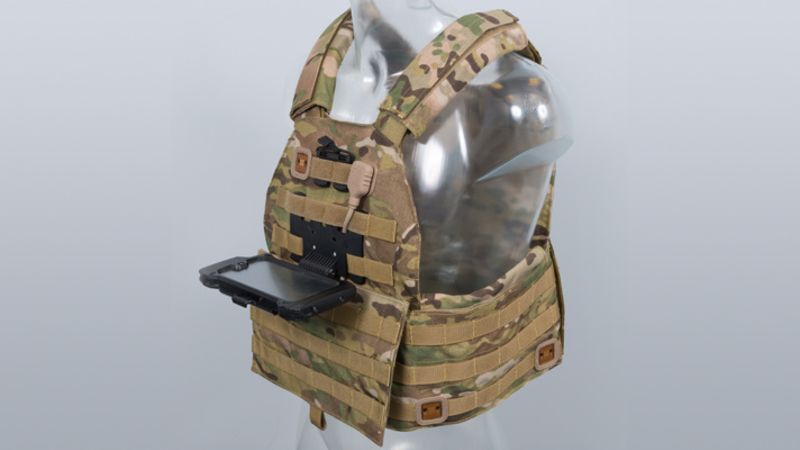Page 11029
Jul 16, 2016
GM Arrogance Spurred Government to Fund Auto Hacking
Posted by Karen Hurst in categories: cybercrime/malcode, government, military
GM executives’ declaration that they didn’t care about automotive security triggered the Pentagon to fund the famous Jeep hack of 2013.
Jul 16, 2016
This Tablet-Toting Military Vest Is Actually a Giant Battery
Posted by Karen Hurst in categories: energy, military, mobile phones
Smartphones and tablets are being used more frequently in the battlefield, and that means that battery power is more important than ever. Soldiers often carry spare battery chargers in the 90-pound combat packs they carry into war zones, but the batteries are often lost or broken. BAE Systems wants to help lighten the load with its new system that lets soldiers plug electronics directly into their clothing.
The BAE Systems Broadsword Spine is a harness that can be sewn into a soldiers vest, jacket, or belt that carries a battery pack and hides charging wires. The harness places the battery pack on the small of a soldier’s back and includes eight conductive fabric conduits that can be used to connect to a USB port.
Jul 16, 2016
Obama Pledges More Than $400 Million for 5G Research
Posted by Karen Hurst in category: internet
Jul 16, 2016
Silicon Valley Entrepreneurs Aim To ‘Hack’ the Brain
Posted by Karen Hurst in categories: bioengineering, chemistry, cybercrime/malcode, neuroscience
Woo and other entrepreneurs are using fasts and other tricks to “hack” their brain chemistry like they would a computer, hoping to give themselves an edge as they strive to dream up the next billion-dollar idea. Known by insiders as “biohacking,” the push for cognitive self-improvement is gaining momentum in the Silicon Valley tech world, where workers face constant pressure to innovate and produce at the highest levels.
Jul 16, 2016
A Fast Acting Drug for OCD
Posted by Karen Hurst in categories: biotech/medical, neuroscience
Summary: A new study provides a deeper understanding of the mechanisms behind OCD and suggests the disorder could be treated by a class of drugs that has been investigated in clinical trails.
Source: Duke.
Brain receptor acts as switch for OCD symptoms in mice.
Jul 16, 2016
Scientists Invent Particles That Will Let You Live Without Breathing
Posted by Shailesh Prasad in categories: biotech/medical, neuroscience, particle physics
Scientists invent particles that will provide oxygen to your body without breathing!!!
This may seem like something out of a science fiction movie: researchers have designed microparticles that can be injected directly into the bloodstream to quickly oxygenate your body, even if you can’t breathe anymore. It’s one of the best medical breakthroughs in recent years, and one that could save millions of lives every year.
The invention, developed by a team at Boston Children’s Hospital, will allow medical teams to keep patients alive and well for 15 to 30 minutes despite major respiratory failure. This is enough time for doctors and emergency personnel to act without risking a heart attack or permanent brain injuries in the patient.
Continue reading “Scientists Invent Particles That Will Let You Live Without Breathing” »
Jul 16, 2016
Virtuix Omni Provides Virtual Worlds in Which to Walk, Run, and Jump
Posted by Dan Faggella in categories: entertainment, health, virtual reality
2016 has been called the year that virtual reality becomes a reality, as some of the most anticipated devices will be made available on the consumer market. From Magic Leap (valued at over $1 billion) to Oculus (acquired by Facebook last year for $2 billion), there’s plenty of interest in the market, and ample room for it.
Though virtual reality is often depicted as an experience for the recliner or gaming chair, a number of VR enthusiasts want us to rethink how we engage with the technology. Instead of sitting around, they’d like to get us moving and looking beyond the go-to medium of gaming. Developers of these new devices consider fields like military training and healthcare as valuable places for mobile virtual reality to be applied.
Leading this approach is a Kickstarter VR company called Virtuix, whose treadmill-like device Omni encourages users to get upright and active. The reason to develop such a device felt like a natural evolution to Virtuix’s former Product Manager, Colton Jacobs.
“If I am walking in the virtual world my avatar is actually walking…”, he says, “…then the body’s natural reaction is, I want to stand up, I want to be walking with this avatar as if I’m actually there.”
Continue reading “Virtuix Omni Provides Virtual Worlds in Which to Walk, Run, and Jump” »
Jul 16, 2016
Pancreatic cancer ‘breakthrough’ hailed
Posted by Dan Kummer in categories: biotech/medical, innovation
Researchers in the U.K. have made what is described as a “breakthrough reclassification” of pancreatic cancer, which offers new opportunities to treat the often-fatal disease.
A study co-led by professor Andrew Biankin and colleagues at the University of Glasgow’s Institute of Cancer Sciences has found four “key subtypes” of the cancer, with each possessing “their own distinct clinical characteristics and differential survival outcomes,” according to a statement released on Thursday.
The researchers’ paper was published in the journal Nature, and named the subtypes as:
Continue reading “Pancreatic cancer ‘breakthrough’ hailed” »
Jul 16, 2016
Scientists Invent Oxygen Particle That If Injected, Allows You To Live Without Breathing
Posted by Magaly Santiago in categories: biotech/medical, neuroscience, particle physics
A team of scientists at the Boston Children’s Hospital have invented what is being considered one the greatest medical breakthroughs in recent years. They have designed a microparticle that can be injected into a person’s bloodstream that can quickly oxygenate their blood. This will even work if the ability to breathe has been restricted, or even cut off entirely.

This finding has the potential to save millions of lives every year. The microparticles can keep an object alive for up to 30 min after respiratory failure. This is accomplished through an injection into the patients’ veins. Once injected, the microparticles can oxygenate the blood to near normal levels. This has countless potential uses as it allows life to continue when oxygen is needed but unavailable. For medical personnel, this is just enough time to avoid risking a heart attack or permanent brain injury when oxygen is restricted or cut off to patients.















